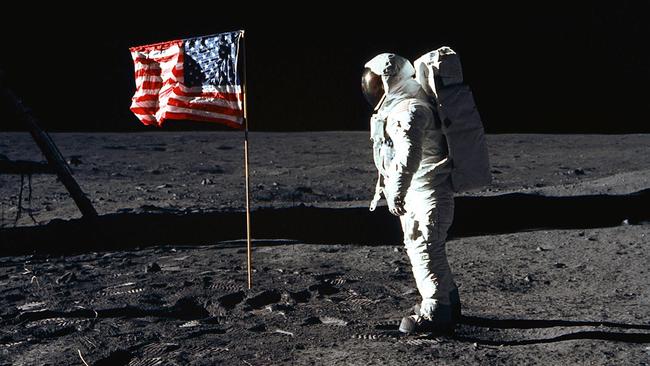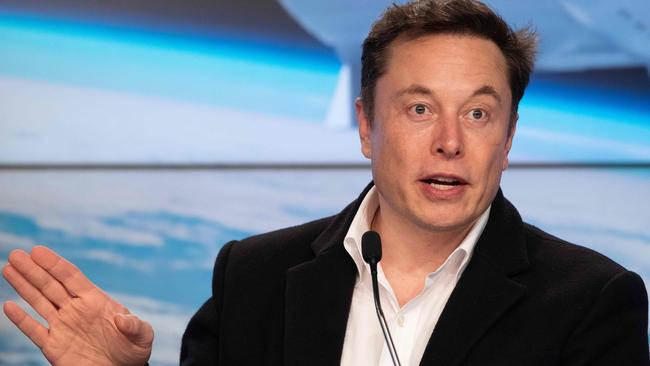Tell big business and politicians their moon plans are sheer lunacy
Everyone has big plans for the moon – from setting up bases there to making it a space refuelling station – but maybe we should just leave it to the romantics.

QWeekend
Don't miss out on the headlines from QWeekend. Followed categories will be added to My News.
The moon is hiding behind a lump of cloud as I drive home late. Brisbane’s streets are at their best after midnight, mostly empty, recent rain making them appear clean.
I’m homeward bound. Past the Mater. Past the freeway.
But can’t sneak past the moon as she breaks through the ragged cloud and stares down, a Cyclops peering back at Earth, maybe grateful this circus is so far away.
What do you make of all this? I say, because talking to the moon is a perfectly sane thing to do late at night. But Earth’s only permanent natural satellite has its own problems.
The barbarians are at the gate. The new race to the moon is on, writes Canadian writer Rivka Galchen in “The Eighth Continent’’ in the latest New Yorker and it’s all for science, profit and pride. Let’s be honest. Profit.
“The Moon is hot again,’’ Jack Burns, the director of the NASA-funded Network for Exploration and Space Science, says.

The Cold War mentality got the US there the first time but now it is private companies hunting for resources on the lunar surface.
The Chinese recently landed a spacecraft on the far side of the moon that we can’t see from Earth. Chang’e-4 is the first vehicle to alight on the far side.
The moon blocks radio communication with Earth, making landing difficult, yet already the rover has found mysterious minerals.
The landing is part of China’s long-term plan to build a base on the moon.
Kathleen Noonan reflects on the wonder of ‘late happiness’
Kathleen Noonan finds her Joe and he’s got an amazing resting place
Meanwhile SpaceIL, an Israeli non-profit organisation, crash-landed into the moon soon after taking a selfie, India’s Chandrayaan-2 moon lander is expected to take off later this year, with Japan’s first lunar-lander and rover mission next year.
The European Space Agency plans to mine lunar ice by 2025 and America has announced plans to return US astronauts to the moon within five years.
NASA would like to establish a permanent presence, using reusable rockets and landers. So it’s going to be as busy as Queen St up there.
Possibly the most depressing thing revealed were the plans for the moon to be a service station for refuelling. “Water is the oil of space,’’ George Sowers, a professor of space resources at the Colorado School of Mines explains, as water can be transformed into rocket fuel.
“The moon could be a gas station.’’ It will pretty much be the Wild West up there. The article is illustrated by a clever cartoon echoing the American frontier land grabs, with a convoy of covered wagons driven by astronauts taking over the moon. What’s that? You thought there were rules governing all this stuff, given we have lawyers and politicians coming out our wazoos here on Earth. No. Incredibly, as for ownership of our lunar friend, the 1967

United Nations Outer Space Treaty says no nation can claim ownership of the moon.
However, that doesn’t necessarily prevent private companies from claiming portions of the moon as their own commercial property.
It’s an ethical conundrum space law experts and ethicists have not solved, which is unfortunate, because the billionaires are circling. Elon Musk’s SpaceX is developing a spacecraft at its facility in South Texas, and Jeff Bezos, chief executive of Amazon, has grand visions of humans living in gigantic space colonies and developing a lunar lander to deliver 3.2 tonnes of cargo to the lunar surface. Which is great.
What the moon needs is clutter and capitalism imported from down below. Haven’t we learnt from our trashing of Mt Everest?
The US has recently announced Project Artemis to put a man and woman on the moon in five years (hoping that chucking a female in there will sweeten the deal).
Problem is President Donald Trump intends to tap surplus funds from Pell Grants to pay for it. Pell Grants pay for poor students to go to college.
The town hunkers down for those lonely hours after midnight. The streets are quiet.
I wish we’d leave the moon alone. Isn’t there anything we humans don’t want to get our damn grubby paws on, make it turn a buck and, eventually, trash it?
The moon is our poetry, our imagination, our stories. I’m an earthbound romantic. I like looking up at the night sky and hearing unruly Tom Waits sing of a grapefruit moon or sunny Doris Day rhyming it with spoon and June.
AND ANOTHER THING …
I am in the midst of a dystopian world, smack-bang in the middle of reading Ian McEwan’s latest, the terrific Machines Like Me, which imagines a future with lifelike robots called Adams and Eves, and it’s turning all very worrying.
A perfect reprieve is a night contemplating science, imagination and the art of the possible at Griffith Review’s latest In Conversation with Australia’s Chief Scientist Alan Finkel, Mark Scott (On Us, MUP), Alice Gorman (aka Dr Space Junk), and Prof Julianne Schultz, publisher of Griffith Review, to discuss how we can devise the best possible future for all.
It’s on June 13, 6.30pm at Queensland Conservatorium, South Bank.
If, instead, you need to lighten up, try a bout of Judith Lucy, surely Australia’s funniest comic, at Brisbane Powerhouse from June 12. She’s reviewing her entire dating history and asking the country if she should continue. The tour is kind of a national referendum, really. A fun, sweary kind.
noonanslastword@gmail.com


